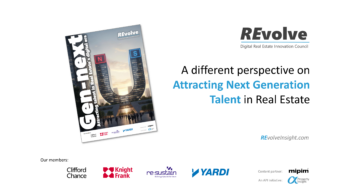It’s nearly two decades since Google revolutionised the workplace with beanbags for meditating and ping pong tables in the board room. Yet what once seemed quirky, has now become mainstream, thanks to the evolving science of space management. Environments which increase productivity and user well-being – with one eye on talent retention – are today in big demand.
“The office is no longer a place of cubicles, desks, a phone,” says Andrea Jang, head of growth Americas, JLL Spark. “People want an environment where they can collaborate, communicate, and access conference rooms.”
In today’s offices, “everything should be at your fingertips and be easy to use. People have Alexa at home – we want to bring that level of ease into the workplace,” Jang adds.
Furthermore, these aspects are crucial in the battle for acquiring talent – and retaining it, says Jang. “Today’s graduates were born with technology,” she notes. “It’s what they expect.”
Even the latest building certifications try to reflect the race for user-friendly spaces, with WiredScore making sure premises have decent internet connectivity – a key element in office-user stress, according to research. Meanwhile, WELL Certification from the International Well Building Institute rewards buildings for their approach to air, water, light, sound and thermal comfort, but also the more nebulous scorecards of nourishment, movement, materials, mind and community.
Space management tech
PropTech has a key role to play in the evolving space management landscape. Space management software from Boston-based Archibus helps companies consolidate space across property portfolios, transform under-used shared space and forecast needs with scenario planning.
Meanwhile, the recent MIPIM Start-Up Competition, held in Cannes in March, was won by a piece of space management tech called Spaceti, which monitors the relationship between buildings and users, to make smart suggestions for an improved use of space. “The system can monitor building usage, ranging from air quality to demand for meeting spaces, to help landlords and occupiers understand how internal layouts can be improved, if materials need to be replaced or greenery added,” says Spaceti co-founder, Aakash Ravi.
And there are a whole range of apps – such as WorkWell and District Technologies – which allow users to better understand the spaces available to them, and make that space work harder. While these site-specific apps enable users to book a meeting room, turn on a light, or even reserve a yoga class, for Workwell’s Marie Schneegans, they also function on a city and even country level. “We’re now expanding by working with property firms who are looking at using the app across the entire portfolio,’” Schneegans explains, “so you can travel across a company’s offices, picking up services in different cities and countries.”
Customer care
Companies today are developing relationships with their employees which are akin to customer care, and SpaceAsAService is central to that, suggests Jonathan Pearce, executive vice president, leasing office and industrial, North America, Ivanhoe Cambridge. “For example, the monolithic office lobbies of yesterday have gone, replaced by much more informal and appealing spaces. You want to increase dwell times, so you need soft seating. Amenities was once a dirty word in offices, you wanted to avoid providing access to leisure – now it’s essential,” Pearce adds.
“We’re building a team within Hines to focus on ground floors in the buildings we manage,” confirms Charles Kuntz, innovation officer at Hines. “Those lower floors have become the most important to add value. We are bringing in hospitality architects to help us do that much better.”
But the debate also raises the question if the happiest workers are those with everything on site – or those in great downtown locations, Pearce argues, with more exciting options on their doorstep. It’s no surprise that centrally located offices in the world’s most dynamic cities – London, Paris and New York – excel in talent relations by also “offering” convenient access to metropolitan amenities.
Flexible options
Happening, downtown locations are part of the success story of the flexible office revolution, led by providers such as Knotel and WeWork, which proliferated around the globe in record numbers last year. WeWork reported launching its 50th space in London in March, in a direct response to demand for convenient sites, the company said.
“When choosing a WeWork market and location, we think about it from our members’ perspective,” says Patrick Nelson, EVP, head of real estate, WeWork EMEA. “Once we’ve chosen a location, the design, technology, and community teams we put in place are all geared toward creating dynamic communities for our members. In fact, we’re increasingly using data from our current buildings to inform how we select, build, and iterate on our future locations.”
Flexible offices are at the forefront of the space management revolution, not least because their space has to be tailored for rapidly rotating tenants with vastly different needs. Monitoring their use informs the way that sites operate and evolve, Nelson adds. And while corporate clients remain the lifeblood of the business, “we never forget about the details or the individual,” Nelson says. “At the end of the day, it’s all about how we can enhance what our members feel when they walk into work every day.”
As innovation coalesces around efficiency and talent retention, the latest PropTech products can prove the difference between success and failure. The conversation continues at MIPIM PropTech Europe, where 1,000 companies and 200 speakers from 40 countries will convene to discuss the future of the industry.



